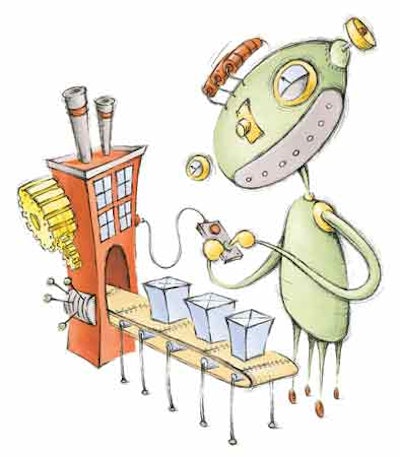Robots never tire. Their silicon-based minds do not wander during an eight-hour shift. Stress-related injuries happen to humans, not robots. Robots are fast, accurate, easier to use than ever before, and—thanks to increasing computer power—capable of performing complex operations. Robots, in other words, are very good at performing the types of tasks that most workers are not good at—high-volume repetitive motion that requires concentration and accuracy, but very little in the way of creative or value-adding thought.
Professor Stanley Dunn, associate dean, School of Engineering, and the director of the Center for Packaging Science and Engineering at Rutgers University, observes, “The one thing you know about a machine is that its function is reproducible and it does not degrade with time. That is why you use a robot. Throughput is one of the primary considerations. How much do you have to produce in a minute, a day, a week? If the packager is not able to meet the throughput requirements manually, then robotics is something they ought to explore.”
Creating value is another consideration when identifying where a robot can be applied. Says Michel Cousineau, project group leader, Johnson & Johnson, Montreal, “We add value by focusing on our core business. We do not want to lose energy on a satellite job such as palletizing but instead spend time, resources, and energy on improving our process and making better products.”
“Remaining globally competitive requires that companies explore technologies such as robotics.”
The most common robotic applications in the packaging industry include pick-and-place material handling, inspection, case packing, palletizing, and de-palletizing.
The Robotic Industries Association (RIA) reports that North American sales of robots for packaging and palletizing rose a total of 113 percent in the five years from 2000 to 2005. According to the association, roughly $60 million was spent last year on packaging and palletizing applications in the United States, a 15 percent increase over the year before.
“Remaining globally competitive requires that companies explore technologies such as robotics,” says Jeff Burnstein, vice president of marketing and public relations, RIA. “As more and more companies achieve success with robots used in packaging, the word gets out and general interest grows in these solutions.”
Following a recent study in Europe, industry analyst Frost and Sullivan concludes, “The booming packaging industry, specifically the consumer markets, offers immense potential for robotics. Changing product types and varying product volumes necessitate flexible automation solutions. Manufacturers in consumer markets are opening up to the idea of investing in robots to reduce costs and maintain quality, thereby boosting sales of robotics in the packaging market.”
Interest is growing
In May, the RIA and the Automated Imaging Association sponsored a workshop on packaging and palletizing applications. Large and small consumer goods, food, and beverage companies sent representatives. Attendee Paul Kafer, assistant vice president of Corporate Engineering, Smithfield Foods, the world’s largest pork processor and hog producer, says, “We have not had the opportunity to apply robotics or vision in our processes. We are just at the beginning of that learning curve. The workshop focused on packing and palletizing, the applications we are most interested in right now.”
Kafer’s interest in packaging and palletizing was shared by a majority of the workshop’s attendees. A pre-event survey identified the top areas of interest to be:
• Palletizing
• Packing
• Vision for inspection
• Vision for guidance
• Depalletizing
Of lesser but still significant interest, attendees wanted to learn more about robotics and:
• Cost justification
• Staff reduction
• Simulation and off-line programming
• Vision for tracking
• Health and safety
• Primary and secondary packaging
A palletizing robot for each production line
Johnson & Johnson’s Cousineau says that palletizing cases of personal hygiene products is an optimal robotic application at the plant. “A dedicated robot with integrated stretch wrapper for each line is ideal for us,” he says. Cousineau reported a 50 to 60 percent reduction in labor costs associated with palletizing. Cases stacked by robots have a higher potential to carry full versus half loads, and there has been a reduction in product damage during transport. Injuries related to ergonomic issues and safety-related costs have both been reduced. At the same time, the plant’s flexibility has increased and its time-to-market has decreased through reliance on robotic solutions.
Cousineau says, “Spending money on multiple, simple robotic systems as opposed to one complex multi-robot system was the optimal solution in our case. Keep thinking about enhancing your ability to be flexible through the use of robotics.” Axium Solutions (www.axiumsolutions.com), is prime integrator for the plant’s robotic systems.
Butch Park, plant manager, Atlas Pellets in Omak, Washington, uses a robot for palletizing multiple sizes of bags of wood pellets, which are used by consumers as a clean, efficient, and environmentally-sound heat source. He agrees with the keep-it-simple philosophy for this application. “My advice is to choose a reliable, low-cost, and easy-to-use robotic system for palletizing,” Park says. “Work with a dependable system integrator. Have the integrator provide accurate data on machine reliability and ease of operation. Our integrator’s track record of on-time delivery, excellent support, and competitive cost helped him win the contract.”
The robotic system at Atlas Pellets has increased throughput by 30 to 40 percent. A simple touch screen control allows operators to quickly switch between different sized bags. Park says this gives operators more time to focus on adding value to the production process. The company improved its on-time delivery performance, reduced stretch wrap costs, and raised the image of its products through neatly stacked pallets.
Atlas Pellets found other benefits as well. Park says, “Before installing the robotic palletizing line, I needed to maintain 28 people on the call list just in case someone wasn’t able to show up. Now I only need to keep a few people on the call list, and I can select the best of them to work for us.” ZYI Corporation (www.zyicorp.com), was the integrator on the project.
“The most common robotic applications in the packaging industry include pick-and-place material handling, inspection, case packing, palletizing, and de-palletizing.”
Three lines and one palletizing robot
Country Pure Foods project manager Calvin Stark’s goal was to reduce the per case cost for palletizing three-, four-, and six- ounce juice cups. Each size cup came down one of three dedicated lines in high volume 24 hours a day. The cups from the three lines are packed on two mixed product pallets. While the length and width of each shipping carton is the same, regardless of cup size, there are five different possible heights. This means the outside dimensions of the blocks are always the same but the tier count varies.
Any cost-reduction solution Stark came up with had to be not only fast, flexible, reliable, and intelligent. It also had to be able to accommodate the limited floor space.
After wrestling with the problem for some time, Stark saw that he needed an automation partner. “My strongest advice for anyone who needs to solve a flexible automation problem such as the one we faced is to hire an integrator with a track record of success,” he says. “Our integrator studied our processes, discussed our goals, and came back with a total solution—from tapers, to robotic palletizing, to stretch wrappers. I think we received the best solution for the money. In fact, if I had chosen to buy the pieces individually and assemble the system, it would have been more expensive.”
A single robot now performs around the clock, accomplishing the work that was previously performed by nine workers. The robot’s small footprint is ideal for the available space. A dedicated palletizer would not have fit the area. Operators set pallet height parameters and the robot automatically picks, places, and stacks cases on pallets to the required height. Flexicell (www.flexicell.com) was the integrator on this project.
After Mickey Hamer, plant manager, Portion Pack Division of H. J. Heinz, installed robots on four case-packing lines for single-portion jelly packs, he was able to reassign four case-packing workers to more value-adding jobs at the plant. The reduction in palletizing headcount significantly reduced the labor cost per case. He was also able to reduce package costs by eliminating the use of trays within the shipping box. He replaced the more complicated trays with a less expensive and simpler chipboard liner inserted between each layer of the jelly packs.
“We were surprised at how easy the system is to operate,” Hamer says. “I am not exaggerating when I say it took a week for the operators to come up to speed.” He advises packagers to work closely with the integrator to identify the performance goals for the robots. “Make sure that you lay out what you expect the robot to do and set those parameters early in the process,” he says. “Our robotics integrator basically built the case-erecting system and top and bottom tape-sealing system to our specifications. The system perfectly complements our packaging line.” Flexicell was the integrator on this project, too
Short runs, varied patterns
Pepperidge Farm began using robots in the late 1980s. Today the company has standardized robotic solutions for high-speed cookie sandwiching and cookie cupping applications, as well as robots for palletizing, case packing, and stacking and unstacking bread pans. One of its latest applications involves robots packing loaves of bread into returnable bread baskets. The application demonstrates the effectiveness of robots in applications that require frequent changeovers.
Pepperidge Farm is a variety bread producer. On any given day, up to 24 different varieties—individual SKUs—will be packed on a single line. Each SKU comes down the line in a mono batch and has an optimal pack pattern in the returnable bread basket. There may be as many as 12 different pack patterns used each day on a line. Before the robotic system, four workers each shift removed the loaves from the line and filled the baskets, using the prescribed pattern for that SKU.
Today a vision system identifies the SKU of the variety about to be packed and inspects each package for proper closure. Two robots per line automatically pick up a group of loaves, according to the SKU designated pattern, and pack the baskets. For example, the robot may pick up four loaves first, then three, and finally five to pack the basket in the correct pattern in the fewest number of moves and shortest amount of time.
The robotic end-effector features suction cups. Each SKU requires its own suction-cup pattern. This means that one end effector can be used for all 24 varieties. There is no downtime needed on the line for changeover when a new SKU needs to be packed. The process is seamless.
“Companies running a dedicated line of a single SKU would not take this route,” says David Watson, vice president, engineering at Pepperidge Farm. “There are much simpler ways to pack a bread basket. When you are running multiple SKUs on a line, however, and you are dealing with a high number of changeovers and pack patterns, robotics offers a viable solution.”
Watson’s advice for selecting a system integrator is to look for one with experience in your industry. “At the end of the day, we want to work with people who are very familiar with the food industry and with the specific issues that we face,” he says. The robots on this line were supplied by Fanuc Robotics (www.fanucrobotics.com).
From blister machine to carton
Heska Corporation is a leader in advanced veterinary diagnostic and other specialty veterinary products. At its Des Moines, Iowa, plant, conventional transfer magazines from blister packing of pharmaceuticals to a cartoner were not feasible because of the wide variety of blister-pack sizes coming down the line. Productivity would suffer every time the line stopped for a changeover of the magazine. The solution was a pick-and-place robotic transfer system capable of handling multiple sizes with no changeover required. The new robotic system allowed Heska to keep this pharmaceutical packaging operation in-house rather than the more expensive option of farming out the operation to a contract packager.
“The booming packaging industry, specifically the consumer markets, offers immense potential for robotics.”
Jeff Knight, pharmaceutical manager at Heska, offers this advice when working with an integrator. “You should always make sure to set up a factory acceptance test with the actual product that you are going to package,” he says. “If you don’t you could run into huge problems once the equipment is installed in your facility. You should also check into the type of service that is available, such as how long it takes to get parts or skilled technicians on site in the event of a breakdown. The key points I use when evaluating integrators are effectiveness, flexibility, cost, reliability, service, and quality.” The Marchesini Group (www.marchesini.com) designed and built this flexible packaging system for Heska.
Robotic picking stations utilize vision for productivity, flexibility, and quality
At a Wrigley facility, robots with suction end effectors and vision systems pick up plastic shells randomly coming down a line and place them in product carriers. The plastic shells are for Wrigley’s Hubba Bubba bubble-gum rolls. Similar robots on a separate random-order line pick up the bubble-gum rolls and deposit them in a specific orientation on their own product carrier. The two lines meet and the rolls are packed into the plastic shells at a rate of 300/min prior to the shells being labeled and then inserted into cases. Defective plastic shells and bubble-gum rolls, or shells and rolls not meeting the specified tolerances, are detected by the vision system and never reach the packing station.
The defective parts simply drop into the reject collection bins at the end of the in-feed belts. Schubert Packaging Systems (www.schubertpackaging.com) designed and built this flexible packaging system for Wrigley.
Robots have leaped off the pages of science fiction stories and landed in manufacturing operations across the world. End users, integrators, manufacturers, and academics agree that robots offer important productivity, quality, and ergonomic advantages in packaging operations. Robots are cost effective, reliable, and perform tirelessly to expectation.
































